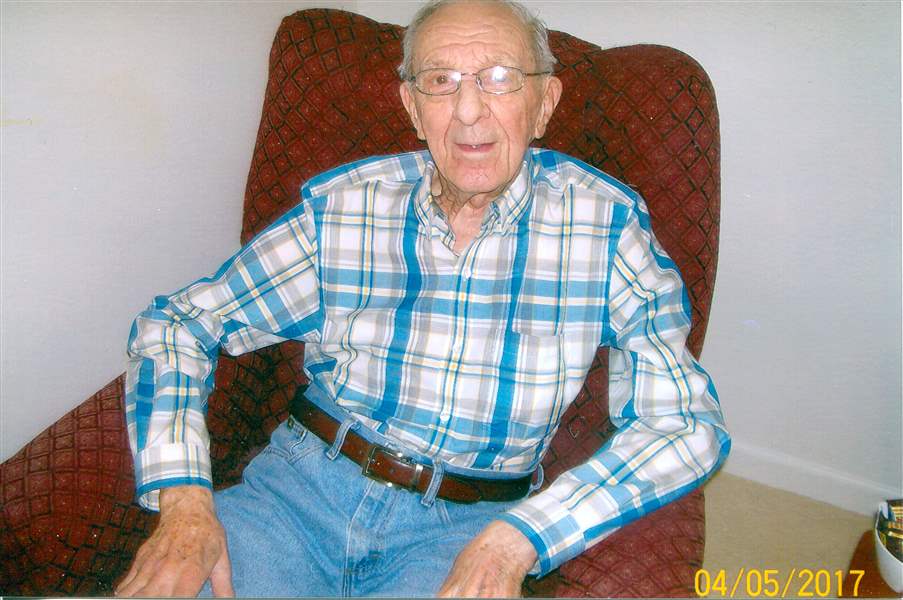
COMMENTARY
America’s Ghost Army used deception to defeat the Nazis
7/2/2017

Frank Myers of Maumee is a veteran of the Ghost Army that served during World War II.
THE BLADE/MARY ALICE POWELL
Buy This Image
With a red, white, and blue background of flags, parades, and that warm, fuzzy American patriotism that runs through our veins, happy July 4 to our veterans who have made Tuesday’s celebration possible.
We all have a list of friends and relatives who have served in the military to protect the United States. My list goes back to World War II, with a special tribute to 90-year-old Frank Myers of Maumee and to the Ghost Army in which he served.
The unit, officially the U.S. Army 23rd Headquarters Special Troop composed of 1,200 hand-picked GIs, is not well known because it was kept classified for 40 years. I have Frank’s wife, Louise Myers, to thank for a letter suggesting the unique troop may be of interest to me for a column.
Mr. Myers recalls that the unit’s mission was not revealed from training at Fort Devens, Texas, until arrival in Europe. He was assigned to drive a truck loaded with the limited artillery the unit was allowed.
The “ghosts” were trained and equipped to fool the Nazis in battle. With rubber tanks and inflatable Jeeps, toy planes, and other phony battle gear, the phantom soldiers participated in 20 major battles across Europe, using specific skills to deceive the enemy.
It is believed that they traveled more miles than any other American Army unit. Gen. Dwight Eisenhower is reported to have said the Ghost Army deception was one of the army’s greatest weapons, and retired Gen. Wesley Clark considered creativity a part of war.
“At every level, the art of war depends on creative planning,” General Clark said. The Ghost Army tactics and success stories are recorded in a fascinating PBS documentary that includes several personal testimonies from unit veterans, including Bill Blass, the celebrated fashion designer.
In the 1940s, Bill was a young man from Fort Wayne, Ind., with budding artistic talent who was hand-picked for Ghost Army duty. His selection was typical of the scrutiny the U.S. government used to gather the most valuable people with art, sound, and radio skills required for the mission of deception.
The search for eligible recruits covered the country.
Young professional and student artists from New York and Philadelphia were chosen to design illusions and camouflage scenery that would lure the Germans to areas without any American troops. The artists set the stage with such believable deceptions that they became known as Cecil DeMille soldiers.
In addition to the battle lines of rubber tanks, inflatable Jeeps, fake airfields, and mannequin soldiers, sound and radio effects were used to deceived the Nazis. Sound technicians used giant speakers to entice the Nazis with the sounds of tanks and trucks moving through forests and over bridges in the dark of night.
The skills of 100 radio technicians were employed to make tapes to fool the enemy. The multi-track tapes were designed to be heard within a 15-mile radius of the Ghost Army location. For example, one tape that was clearly overheard was the voice of an American soldier yelling, “Put out that cigarette now.”
The “ghosts” followed the war route and set up phony camps at Normandy, the port city of Brest, Omaha Beach, Metz, the Battle of the Bulge, and the Rhine River crossing.
The Rhine crossing is believed to have been one of the biggest surprises to the Germans, who had vowed the river would run red with American blood but instead were confronted by empty fields at the battleground.
Although the Ghost Army participated in, or very near, major battles, the unit suffered only two casualties and 15 injuries.
The PBS documentary reminds viewers that there were also happy times for the phantom soldiers. The artists took advantage of sketching the European scenery and landmarks, but for Bill Blass, down time was an opportunity to copy European fashions on his sketchpad.
After serving nearly two years in the Ghost Army, Mr. Myers was discharged at Fort Dix, N.J., in 1946. He attended college on the GI bill, which prepared him for the position of financial analyst for Owens-Illinois.
In retirement, he and Louise have traveled to all 50 states and to Australia. In September, they will celebrate their 66th wedding anniversary with their son David, daughters Denise Holler and Diane Weik, and their three grandchildren and seven great-grandchildren.
Mary Alice Powell is a retired Blade food editor. Contact her at: poseypowell@aol.com.